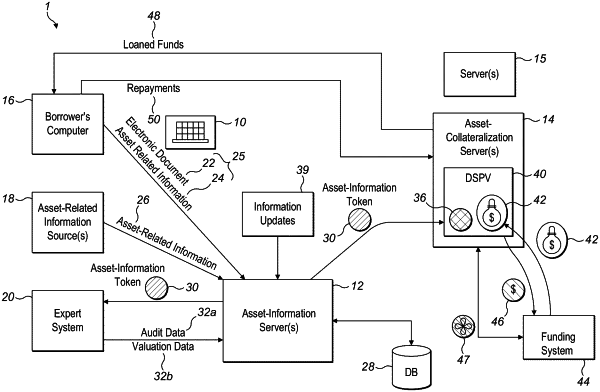| CPC G06Q 20/0658 (2013.01) [G06Q 40/03 (2023.01)] | 23 Claims |

|
1. An automated method of collateralizing an illiquid asset, the method comprising the steps of:
receiving, by a first server, an electronic document comprising a digital representation of the illiquid asset, the digital representation identifying a financial interest in the illiquid asset by a borrower;
hashing, by the first server, the digital representation of the illiquid asset to generate a first hash value;
recording, by the first server, the first hash value on a first blockchain;
storing, by the first server, the digital representation of the illiquid asset at a first memory location;
generating, by the first server, an asset-information table that associates a location of the first hash value on the first blockchain with the first memory location;
receiving, by the first server, an asset-valuation data concerning the illiquid asset;
storing, by the first server, the asset-valuation data at a second memory location;
hashing, by the first server, the asset-valuation data to generate a second hash value;
recording, by the first server, the second hash value on the first blockchain;
updating, by the first server, the asset-information table to associate a location of the second hash value on the first blockchain with the second memory location;
generating, by a second server, an asset-value token comprising an association with the updated asset-information table;
recording, by the second server, the asset-value token on a second blockchain;
determining, by the second server, an amount of digital currency for an automated digital transaction based on a programmed set of rules using the asset-value as a parameter;
generating, by the second server, a data structure comprising a self-executing digital program for performing the automated digital transaction, the data structure including the asset-value token; and
recording the data structure on the second blockchain;
wherein the automated digital transaction involves loaning the amount of digital currency at a rate of interest determined using the programmed set of rules, and wherein the illiquid asset, via the asset-value token, constitutes a collateral for the amount of digital currency being loaned.
|